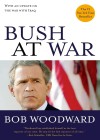Bush at War
Written by: Bob Woodward,
New York, Simon & Schuster, 2002,
ISBN: , 376 pp.
Reviewed by: Dr Alexandra Siddall, Department of Foreign Affairs and Trade
In Bush at War, Bob Woodward provides an informative and non-partisan account of the presidential decision-making process in the hundred days following the terrorist attacks of 11 September 2001. During this period, the United States prepared for a war in Afghanistan against al-Qa’ida and the Taliban, took steps towards a pre-emptive strike against Iraq, intensified homeland defence, and began a well-funded CIA covert war against terrorism around the world. Woodward’s scrutiny of the meetings that led to these actions also gives insight into the personality of President George W. Bush and his cabinet.
Bob Woodward, an assistant managing editor of the Washington Post, has been a newspaper reporter and editor for more than thirty years. It is no surprise, therefore, that he uses a newspaper reporting style. His narrative is based on tape-recorded interviews of over a hundred sources, including four hours of exclusive interviews with the President, along with notes from National Security Council meetings and access to some classified reports.
This demonstrably high-level access to the Bush administration’s principal players (something very few researchers obtain) is the strength of this work. Woodward gained access directly after events while minds were fresh and notes legible. his ‘virtual wiretap’ into the White House Situation Room reveals an interesting portrait of an untested president and his advisers.
Vice President Dick Cheney appears consistently hardline, always pressing for more urgency in Afghanistan and towards Iraq. Secretary of State Colin Powell is portrayed as the cautious diplomat and loyal solider, tasked with building an international coalition in an administration prone to unilateralism. Defense Secretary Donald Rumsfeld emerges as the agitator and media star who led the military through Afghanistan and, he hopes, through Iraq. Surprisingly, National Security Adviser Condoleezza Rice, the ever-present troubleshooter, emerges from the record as the President’s most important and trusted adviser. Bush is dependent on her for candid advice as well as for conveying his thoughts to his cabinet. Woodward’s description of the rivalries and interplay between cabinet members is intriguing, and supports recent analysis and commentary.
Woodward’s exploration of the president’s leadership style and his motivating forces is particularly interesting. Bush describes himself as a ‘gut player’ who relies heavily on instinct. Much of this instinct derives from his strong Christian, and almost Manichean, belief in good and evil. This is no more conspicuous than in his statements that Osama Bin Laden was wanted ‘dead or alive’.
Perhaps more importantly, Woodward provides insight into the process of policy development. He does an excellent job of exposing the seat-of-their-pants planning sessions, and on-the-run policy decision-making conducted at the highest levels of power. This tendency towards crisis management is exacerbated by Bush’s reliance on his ‘gut instinct’. The revelation that the President developed and publicly stated the so-called Bush Doctrine—the policy that the United States would not only go after terrorists everywhere, but also those governments or groups that harbour them—without first consulting Cheney, Powell or Rumsfeld is particularly telling.
Woodward included in his account a description of how CIA Director George Tenet prepared a paramilitary team to infiltrate Afghanistan and set the groundwork for invasion. This inclusion was particularly useful in making the link between policy development and implementation or application of policy. It also helped illustrate the new era of cooperation between the CIA and the Defense Department.
Although not pivotal to this account, the strained and sometimes explosive relationship between Powell and Rumsfeld (and to a lesser degree Powell and Cheney) exposes their differences over how to deal with Iraq and the appropriateness of coalition building. Moreover, this relationship is indicative of the perennial tension in US foreign policy—and between foreign policy makers—between the demands of multilateralism and the inherent US preference for unilateralism.
Woodward does not seek to provide an authoritative examination of US foreign policy in 2001-02, or on the politics of the War on Terror. He makes no evaluation of the events about which he is writing, nor does he add much to the narrative in the way of background information. Nevertheless, Bush at War provides a useful contribution to the academic literature on the process of presidential decisionmaking in the United States, and useful source documents for further research on this area.
The book was written before the recent war in Iraq and only contains a few references to the problems with Iraq, although it is constantly on the minds of the principals. I would enjoy reading a similar type of account from Woodward of the decision-making that took place leading up to and during the second war in Iraq.
The author has written a highly readable book with direct language and mostly fast-moving narrative. It is worthwhile, and in many cases, enlightening.

